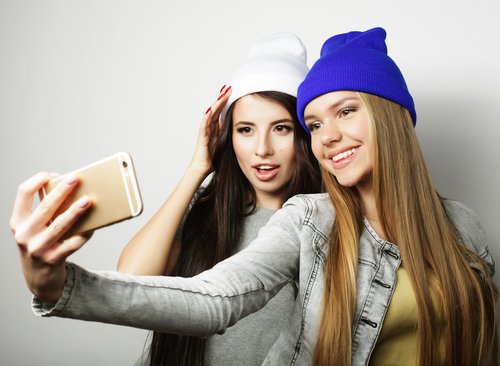The Effect of Instagram on Teenagers

Distress, depression and anxiety. The effects of Instagram on teenagers can be very harmful. This doesn’t have to do only with the risks that teens expose themselves to. It also involves the feelings that this social media platform produces.
A network that grows every day
The accelerated growth of Instagram seems to be endless. The ability to share images is something that today’s adolescents are passionate about, even though it means sacrificing their privacy. This famous social media platform allows teens to show everything they want to share in just one place.
Instagram is a network that encourages the formation of interpersonal relationships, with all the risks that they imply. In practice, this platform, which is suspected to surpass 111 million users in 2019, is a place to express oneself. And that is what users do, most of whom are between the ages of 16 and 30.
Self-worth and external recognition are fundamental issues for teens. Some confuse affection with “likes” on their photos. Others link it with popularity, a major goal among adolescents.. If the number of likes they receive is low, then they prefer to erase the image rather than recognize that it wasn’t effective.
Instagram is also a popular place to establish one’s own identity and to offer emotional support. People establish personal connections within online communities, but the risks are exponentially higher.
Bullying, a risk that comes with Instagram during adolescence
Bullying can be one of the consequences of exposing aspects of one’s personal life on social media. Anxiety and distress, which can even lead to depression, are other risks of sharing your private life with so many people. Fear of criticism arises and discomfort increases.
The new functions of Instagram broaden the problem. The ability to share stories on user profiles attracts more and more followers every day. And this is just what young users value: The number of followers they have and the number of likes their photos get.
The photos with the most likes
Teenagers also evaluate what types of photos get the most likes, which are signs of approval from other users. If it’s a photo where the user appears alone, a like means recognition – but this can also lead to narcissistic attitudes. Likes on photos of events or gatherings give users more representation.
Being careful with strangers
Every day, more and more teenage users are accepting followers that they don’t know. What’s important for them is raising their numbers. Many teens have a very elevated number of followers, which heightens their commitment to keeping their account up to date. This can cause teens to experience episodes of anxiety.
Furthermore, risk lies in the motives of these strangers. Who they are and what they want should be standard questions. On many occasions, pictures posted on social media end up being used for other means. Often, they’re used for cyberbullying, which affects a great number of teens in the world.
“The ability to share images is something that today’s adolescents are passionate about, even though it means sacrificing their privacy”
The threat of depression
Youth may fall into a deep depression if their pictures are exposed in a humiliating way. Once this content becomes viral, there’s no way to stop it. Some adolescents even consider drastic measures, such as self-injury and addiction, as a way to get away from this reality.
To reduce the negative effects of Instagram on teenagers, family guidance is a must. In cases where adolescents suffer bullying or experience feelings of anxiety from being immersed in this social media platform, they may also need the help of a professional.
Mental health at risk
With each interaction with Instagram, teenagers put their mental health and well-being at risk. This is a complex age, given the typical vulnerabilities of adolescence.
If teens spend more than two hours on this social network, they’re more prone to suffering psychological consequences… Especially anxiety, distress and even depression.

Because of their Instagram use, the amount of rest that teens get goes down significantly. Their self-esteem suffers and their doubts about their own self-image increase. Consequently, they begin to adopt a more pessimistic outlook on life in general.
In order to avoid rejection and criticism, many teens edit their photos or use filters to improve their image. The fear of losing recognition haunts them, as does the fear of becoming a victim of cyberbullying.
The effects of Instagram on teenagers can be very harmful if teens aren’t aware of the best way to use the platform. Protecting their privacy is the best way to avoid major issues. Only interacting with people they know and being careful about what they post are both wise recommendations.
All cited sources were thoroughly reviewed by our team to ensure their quality, reliability, currency, and validity. The bibliography of this article was considered reliable and of academic or scientific accuracy.
- Aydn, B. y Volkan Sar, S. (2011). Internet addiction among adolescents: the role of self-esteem.Procedia Social and Behavioral Sciences, 15, 3500–3505.
- Bringué, X. y Sádaba, C. (2011). Menores y redes sociales. Madrid: Foro generaciones interactivas.
- Calderón, C. A., López, M., & Peña, J. (2017). El efecto condicional indirecto de la expectativa de rendimiento en el uso de Facebook, Google+, Instagram y Twitter por jóvenes. Revista Latina de Comunicación Social, (72), 590-607. https://www.redalyc.org/pdf/819/81952828031.pdf
- Mattei, M. M. (2015). El divismo en tiempos de# Instagram. CIC. Cuadernos de Información y Comunicación, 20, 95-107. https://www.redalyc.org/pdf/935/93542537009.pdf
- Wang, N. y Yongqiang, S. (2015). Social influence or personal preference? Examining the determinants of usage intention across social media with different sociability. Information Development (2015): 0266666915603224.
This text is provided for informational purposes only and does not replace consultation with a professional. If in doubt, consult your specialist.








